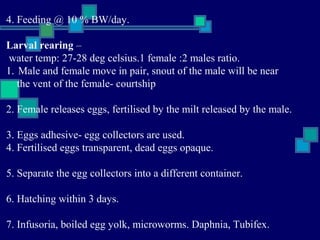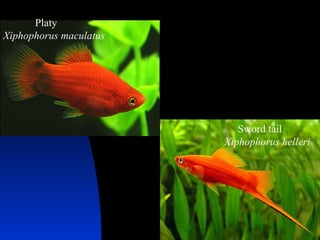Ornamental fish breeding
- 2. Global trends in trade Worth 15 billion USD, 2 billion live ornamental fish traded. More than 2500 species traded all over the world 35 of FW species dominate world market. Asia – largest exporter of tropical ornamental fish to the global industry -56% Among Asian exporters, Singapore is the largest- 38%, followed by Malaysia (14%), Japan(12%) and Thailand( 8%) After Asia, the European Union is the second largest exporter with 29%. Czech Republic leads the countries with 38%, followed by Netherlands & France. From the American region, US is the largest exporter. Indian ornamental fish sector is small, dominated by wild caught species Current production 100 million fish worth 1.26 million USD in 2010-11.
- 3. Most of the ornamental fish activities concentrated in 5 states- West Bengal, Maharashtra, Karnataka, Tamil Nadu and Kerala. Indian exports are mainly to South East Asia,China,Middle East, EU, USA and Japan.
- 4. Aquarium fish divided into two categories I. EGG LAYERS II. LIVE BEARERS a. Egg layers with no parental care Fertilisation internal. b. Egg layers with parental care Ex. Guppy,Platy ,Mollies Egg depositors- rasboras Sword tail Egg buriers - Aplocheilus panchax Egg Anchorers – Angel fish Nest builders –Betta, Gourami, Egg carriers- Tilapia, other cichlids
- 6. I a. EGG LAYERS with no parental care. With adhesive eggs – Gold fish , barbs, tetras. GOLD FISH About 126 breeds of fancy gold fish – Shubunkin, Comet, Fringe tail, Telescope moor, Oranda, Lion head, Veil tail Sexual dimorphism 1. Tubercles on head, operculum, and on pectorals on males. 2. Belly bulging female 3. Genital opening rounded and protruded in female, long, oval in male Brood stock development 1. 8-15 month old fish ( 40 -100 gms) 2. Feeding thrice daily, tubifex during morning and evening and 3. Formulated feed in the afternoon.
- 7. 4. Feeding @ 10 % BW/day. Larval rearing – water temp: 27-28 deg celsius.1 female :2 males ratio. 1. Male and female move in pair, snout of the male will be near the vent of the female- courtship 2. Female releases eggs, fertilised by the milt released by the male. 3. Eggs adhesive- egg collectors are used. 4. Fertilised eggs transparent, dead eggs opaque. 5. Separate the egg collectors into a different container. 6. Hatching within 3 days. 7. Infusoria, boiled egg yolk, microworms. Daphnia, Tubifex.
- 8. I. EGG LAYERS with no parental care and non adhesive eggs- Danios, Brchydanios. I b. EGG LAYERS WITH parental care Egg depositors- rasboras Egg buriers - Aplocheilus panchax Egg Anchorers – Angel fish Nest builders –Betta, Gourami, Egg carriers- Tilapia, other cichlids
- 10. Egg Anchorers – Angel fish 1. Cichlid, native of Amazon river basin. 2. Grows upto 6 in. 3. Laterally compressed body, thread like filaments from the tail fin, dorsal, ventral and pectoral. 4. Female with larger vent 5. Introduce a mature pair into an aquarium 6. Ideal water quality- pH6.8, alkalinity 50-100 CaCO3 mg/litre 7. Live feed- brine shrimp adult, mosquito larvae tender earthworms. 8.Provide aq.plants/ flat surface for attachment of eggs. 9. Parents attach the eggs in rows, fanned. 10. Incubation period is 4 days. 11.Remove parents. 12. Hatchling attached to the surface by a sticky thread on the head. 13.Yolk absorbed within 3-4 days, fry drops to bottom. 14. Fed on Paramecium, then Artemia nauplii.
- 11. Siamese fighting fish Betta splendens
- 12. Nest builders –Betta splendens 1. Native to Thailand, adult 6cm. 2. Anabantoid fish- labyrinth organ. 3. Males are very aggressive. 4. Sexual maturity at 3 months. 5. Distinguished from female by the larger, longer fins and brighter color. 6. Breeding tank with partition.Male and female separate. 7. As soon as the male starts building bubble nest, the partition removed. 8. Nuptial embrace, eggs released and fertilised. 9. About 15 eggs released in one embrace, this continues for many hours. 10.Final brood- 200-300 eggs. 11.Male fish collects the eggs, spits them into the bubble nest. 12.Female is removed, male stands guard, removed after 3 days. 13.Eggs hatch after 36-48 hrs. 14.Fry become free swimming after 5 or 6 days, accept infusoria/egg yolk milk.
- 13. II. LIVE BEARERS Molly Poecilia sp. Guppy Poecilia reticulata
- 14. Platy Xiphophorus maculatus Sword tail Xiphophorus helleri
- 15. Lower part of the anal fin modified into a thick rod- like structure GONOPODIUM. The female stores the sperm for long periods, uses it to fertilise ovum. Female has a tendency to eat its own young ones, gravid female shifted into breeding traps with perforations. After abt 4 wks of gestation, the young ones are capable of swimming, searching for food and taking refuge. Guppy 20-100; Platy 10-100; sword tail 20-100; Black molly – 30-70. (Refer ICAR handbook)















